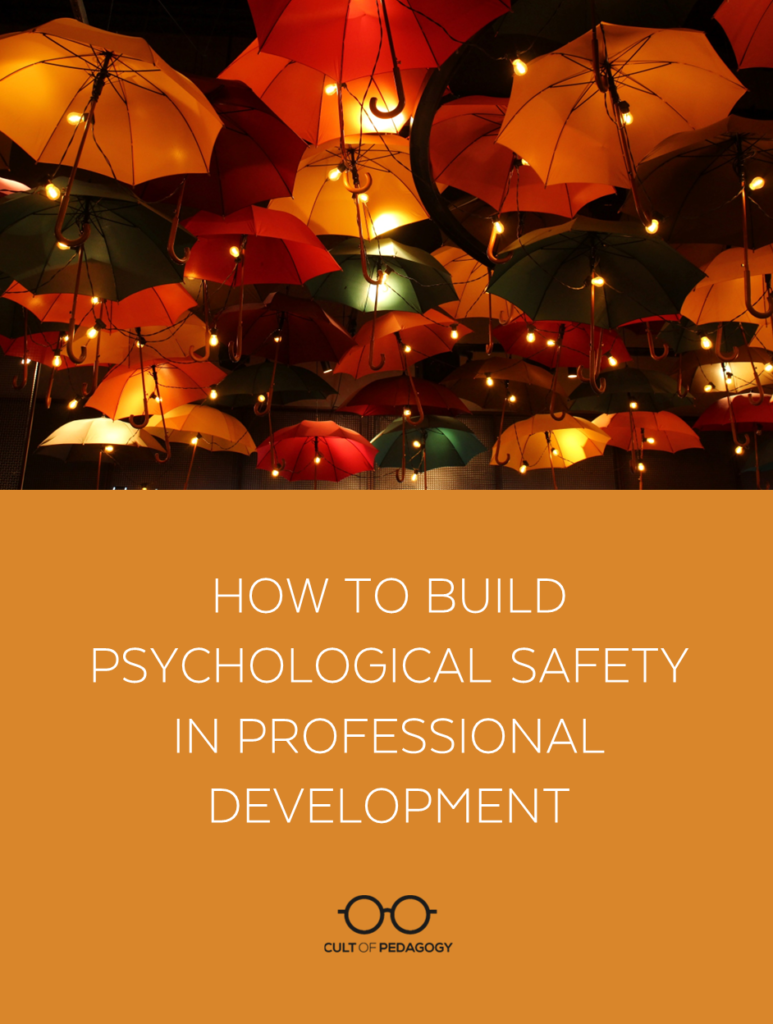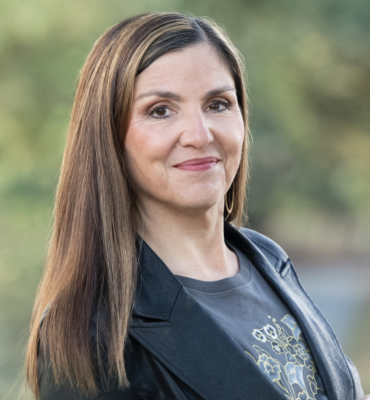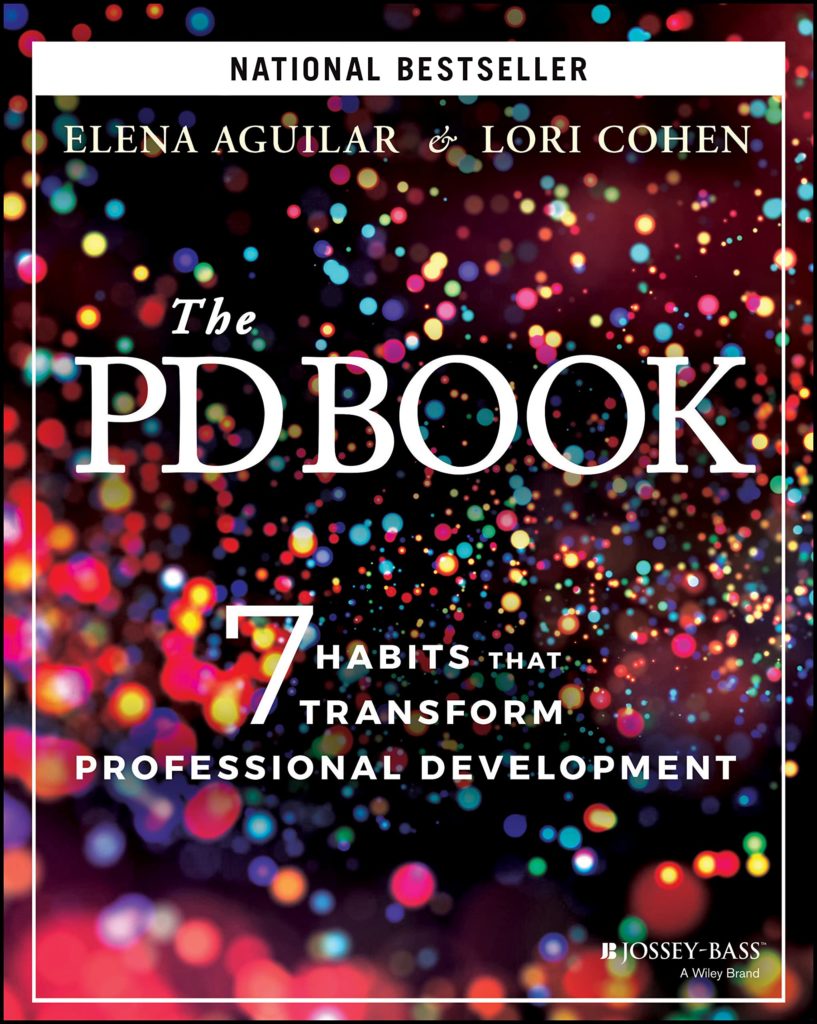
Listen to the interview with Elena Aguilar (transcript):
Sponsored by Hapara and JumpStart
This page contains Amazon Affiliate and Bookshop.org links. When you make a purchase through these links, Cult of Pedagogy gets a small percentage of the sale at no extra cost to you. What’s the difference between Amazon and Bookshop.org?
Anyone who has ever been a teacher has participated in a lot of professional development. If you’re lucky, some of that has been time well spent, giving you new tools and helping you grow as an educator. Unfortunately for many of us, that isn’t the case much of the time. Hearing a teacher say, “I can’t wait to spend all day tomorrow in PD!” is something that almost never happens.
And why is that? Well, there are lots of reasons. One is that our PD is often designed to be one-size-fits-all, which means a lot of people in attendance will feel that the content isn’t relevant to their work. Another is that PD is often structured in a top-down fashion, where participants are passively receiving information, with little acknowledgement or use of their personal expertise. And another is that hardly any effort is made to ensure that the people in the room — the adult learners — feel physically and emotionally comfortable enough to give their full participation.
These are problems Elena Aguilar is attempting to solve in the book she co-wrote with Lori Cohen, The PD Book: 7 Habits that Transform Professional Development (Amazon | Bookshop.org). The book is full of incredibly insightful advice — stuff that really focuses in on the idea that PD is ultimately about groups of complex human beings gathering together to learn and grow. If you’re a facilitator, the book will help you do your work better. If you’re someone who plans PD and hires folks to come into your school, it will refine what you’re looking for in that process. And if your role is primarily as a participant, it may help explain why you feel dissatisfied sometimes, and provide you with a blueprint for what powerful PD should look like.

On the podcast, Elena and I explored one specific piece of the book, the importance of establishing psychological safety as part of the groundwork of good PD. This topic is especially interesting to me, because too many of my own PD memories include sitting with people who intimidated me, feeling like I couldn’t ask questions or speak up about concerns I had, even at times acting like I wasn’t interested in the material we were learning because apathy was the prevailing mood of the room and I didn’t want to look uncool. What I love about teaching is that there is no end to the ways we can grow and develop our craft, and the thought of doing that in a space where I feel psychologically safe is really appealing.
In our conversation, Elena shared five specific things PD facilitators can do to build that psychological safety for participants. You can listen to the interview or read the full transcript above. Below I’ve summarized her key points.
Why Is Psychological Safety Essential for Effective PD?
“When we’re afraid, our brains basically shut down,” Aguilar explains. “If we feel like someone, especially someone in power, poses a threat to our well-being, then what happens in our body is it goes into protection mode, it prepares for battle, it generates hormones, neurochemicals to help us survive, our attention narrows and it focuses on little cues from the person who has power to indicate when it is time to flee or fight or freeze or appease. And yes, this happens even when you are in a PD session in the library.”
She acknowledges that although the word fear sounds a bit dramatic for what we experience in professional development, “fear often shows up as anger or frustration…(such as) the frustration of My time is being wasted. There’s other things that are more important. The fear is of not having the kind of impact we want to have, of not being able to express ourselves the way that we want to, of not having meaning. Fear is often hiding under a lot of our uncomfortable emotions, including, often, anger or frustration.”
To illustrate, she describes a typical scenario. “Say you go into a PD session and the facilitator has a Do Now, and there’s a timer going, and the do now is asking a question that makes you feel like, Oh, there’s a right and a wrong answer to this. You’ve come in after a really busy day during which maybe you didn’t have prep, maybe you didn’t have lunch. So that is all either subtly or not so subtly heightening the stress, the anxiety. And then the facilitator says, Time’s up, and says, Okay, I want you to walk around the room and when the music stops, grab a person, and you’re going to share your answers with.
“Now again, consciously or unconsciously, there’s a pressure, many of us are going to feel kind of nervous, like, Who am I going to be with? Am I going to feel comfortable talking to them? There’s all these very subtle small ways in which we either build a sense of safety, the conditions in which we can relax, or we heighten the tension, the pressure, the anxiety. Am I going to be called out? Is my status going to be preserved? Am I going to be seen as someone who knows something?
“Learning requires us to be vulnerable and yet facilitators often don’t create the psychological safety, the conditions in which we can be vulnerable, take risks and say, I don’t know.”
5 Ways to Build Psychological Safety for Teachers
1. Cultivate Your Emotional Intelligence
The first thing a PD facilitator can do is to work on themselves.
“Everything starts and ends with you,” Aguilar says. “Our emotions are contagious. When you are facilitating PD, you have power. Learners look to you for cues about how you feel, and they mirror your emotions. If you walk into a room and you’re feeling annoyed by the participants, by the learners, the teachers in that room that you’re going to facilitate a learning experience for, they’re going to pick up on that. If you walk in communicating openness and acceptance, and if you feel like your learners are skilled, capable, smart, caring people, then your learners, the people in front of you, are much more likely to be open and receptive. So what you think and feel is everything.”
Emotional intelligence covers a variety of skills, most importantly the ability to regulate your own emotions and the ability to accurately recognize and relate to the emotions of others. Building these skills isn’t a quick process, but its benefits extend far beyond the school environment. “Your life improves, your relationships with everyone improve when you learn how to understand your own emotions, to recognize them, to regulate or manage them, to build your resilience. That improves your life outside of your professional context.”
2. Cultivate the Group’s Emotional Intelligence
Even if a facilitator has a high level of emotional intelligence, that’s not enough if the group is lacking in those skills. “You’re going to be a lot more effective if you find ways to teach people how to understand their own emotions, how to navigate the emotions of others,” Aguilar says.
But if you only have limited time with a group, how can you accomplish that? It can be as simple as taking a few minutes at the beginning of a PD session to invite participants to take turns around their tables, identifying three words that describe how they’re feeling at that moment. “This just gives people a chance to bring awareness to their emotions, which is something that often we feel like we don’t have time to do,” Aguilar says. Giving participants a list of emotions to choose from helps them access vocabulary they may not have on hand.
“It gives people an opportunity to cultivate self-awareness and empathy for each other,” she explains. “And so the teacher who walks in and says, Right now I’m feeling frustrated, disappointed, and disheartened because I put so much time into this lesson that I did today, and it flopped, and I’m just feeling like I am not making any growth as a teacher. I feel hopeless. What happens then is everybody sitting around that teacher feels that, right? We feel empathy, and so then we realize, okay, she’s kind of grumpy. I’m not going to take it personally, and actually I feel like I get it. I resonate. So that’s a way to cultivate group emotional intelligence, and that’s just one example of an activity you can do that helps that happen.”
3. Explicitly Teach Communication Skills
“Maybe you can recall being in a PD session where you felt like your colleagues weren’t really listening to you,” Aguilar says, “or someone else talked over you, or you felt like other people judged you for your ideas. And maybe you kind of started checking out, and you felt like This PD is not really helpful. In order to create psychological safety, we need to have effective communication between people.” And because most people won’t come to a PD session already equipped with those skills, it’s up to the facilitator to help.
If you’re working with a group over a long period of time, it’s beneficial to set aside longer blocks of time early in the process to teach a comprehensive set of communication skills, but if that time isn’t available, you can also accomplish a lot in shorter moments.
“In a lot of my workshops,” Aguilar says, “I teach people how to just become aware of how they’re listening. So often when we are listening to other people talk, we do a number of things, including thinking about our rebuttal, thinking about stories that we’re going to share in response, thinking about how we’re going to tell someone they’re wrong, thinking about questions that we want to ask to sort of challenge their thinking. It’s not listening.” She encourages her participants to pay attention to how they are listening, and then consider ways they could make adjustments. “Do I want to move into listening from curiosity? Can I be curious about what someone is really expressing? Can I listen to what they’re saying for possibility, for hope? Can I listen with compassion? Learning how to ask questions, questions that are non-judgmental, questions that help someone truly probe for what they’re understanding or what they’re thinking. These are all topics that could be mini lessons.”
4. Use Norms and Community Agreements
A norm is “an agreement about how we’re going to show up together,” Aguilar says, “how we’re going to be in a way so that we can learn together. They’re essential in any group to begin with. How are we going to treat each other?”
Those norms can come from within an organization, if that group already has experience working with norms. If not, the facilitator can offer a set of their own. When Aguilar is presenting to new groups for short periods of time, “the norms that I offer are Take care of yourself, Be fully present, Take risks, and Be mindful of other learners.”
These sound good, but they won’t really work unless participants understand what they look like in practice. “It’s essential that there is some meaning making about what these mean,” Aguilar advises, “some discussion of, what does it mean to be mindful of other learners? That means don’t interrupt each other. It means come back from breaks on time. It means no side conversations, that kind of thing.”
Another important part of using norms is to address when they are breaking down, which leads us to our final point.
5. Address Conflict and Breaches of Psychological Safety
If participants start to move away from the agreed-upon norms, or if conflict arises, this can threaten the psychological safety in the group. When this happens, it’s up to the facilitator to address it in a constructive way so that it doesn’t derail the whole session.
“So, for example,” Aguilar says, “if you’re perceiving tension, you can say something like, I’m noticing that there’s disagreement about how to use this engagement strategy. So I’m going to create time for us to hear different perspectives and work this out.”
Aguilar shared one example of a time when she had to address a breakdown of the norms that had been established in a PD session. “I was presenting a two-day workshop, and in the afternoon on the first day, I noticed that a lot of agreements were being ignored. I was asking people to do silent activities, and people were engaging in side conversations during small group activities. People were on email. And my first thought was, well, okay, if people don’t find this useful or if it’s not relevant to them, then fine. That’s their choice. They can check out. I was trying not to be triggered or reactive, but I was also recognizing that the whole learning environment felt like it was deteriorating.”
When she realized these behaviors were negatively impacting the experience for others, Aguilar knew she had to act. “Some of the learners who were really engaged were looking at me. I felt like I could hear the thoughts — these were the learners I wanted to keep. These were the people who were engaged, and I felt like I could hear that they were thinking, Is she going to do anything or is she going to ignore that? And in that moment, I knew that I was risking losing the trust of the people who were engaged, and I risked deteriorating the psychological safety that I had been developing, and I realized it’s my responsibility to say something.”
As she prepared to address the group, “I felt so nervous. My heart was racing. And I was like, okay, I’m afraid, and I’ve got to take a stand for what matters. And that’s what my fear is telling me: This matters. It’s going to be worth it. So right before this scheduled afternoon break, my heart is racing, my palms are sweating, I’m holding the microphone, and I say to the 150 people, I’m feeling really uncomfortable right now, but I have to name something I’m observing. Over the last couple of hours, I noticed that some people have been disengaging from this learning. And my concern is about the impact that that’s having on others in your groups. Some of you have noticed me noticing this. You’re watching me noticing what’s going on, and I realize that I’m risking losing your trust that I can hold this safe, focused learning space unless I name this breakdown of the norms. This feels really awkward to say, but it’s my responsibility to make sure this is a safe learning space. If you are unable to participate in these activities, for whatever reason, I invite you to step out and return when you are. So if you’re in this room, I’m asking you to recommit to these community agreements and keep this space focused on learning.”
What followed was applause from about half the group. During the planned break that came next, attendees came up to Aguilar and thanked her for speaking up.
And when the break was over?
“Everyone came back,” she says. “Everyone came back. There were no phones out. It turned into a really powerful learning experience. Sometimes I feel like people want to be called on their behavior. They want someone to say, This is important.”
BONUS: Recognize Your Sphere of Influence
Even with all of these tools in hand, Aguilar says “it’s important for a facilitator to recognize that there are some things that can make it really hard or even impossible to create psychological safety. In a school or an organization where there’s just a lot of toxicity, it can be really hard to create psychological safety and deliver the kind of PD that you might want to deliver. You can have a group where there are a couple of people who are struggling in a way that impacts the entire group. You could use all of the strategies in my book and still feel like I can’t create psychological safety or do the kind of transformative PD that I want to do. There’s a limit and it’s important to recognize that the times when you need to build your own skills and do more, or times when you need to say, I’ve given it all that I can.“
Safety is the Bare Minimum
As important as psychological safety is, Aguilar hopes facilitators won’t stop there.
“Safe is the minimal required condition for learning,” she says. “I want to think about creating places where people feel calm and centered and connected and curious and engaged and absorbed and joyful and satisfied. I want to create an experience that we walk away from saying, That was so great. I learned so much. I feel so energized. It was so much fun. I feel like I know people better. A PD space is a learning space. In order to create the kind of world that I know so many of us want to create, we need to learn. We need to learn new skills, all kinds of skills. And if that learning space can be joyful and energizing and really just fulfilling, we can create those schools, the communities, the classrooms, the society in which people will feel not only safe but connected and energized and joyful. Creating psychological safety is essential, but let’s not stop there. Let’s have bigger aspirations.”
You can find all of Elena Aguilar’s resources on her website, Bright Morning. And if you like what she has to offer in this post, you won’t want to miss the first time she appeared on the podcast, when she talked about how teachers can build emotional resilience.
Join our mailing list and get weekly tips, tools, and inspiration that will make your teaching more effective and fun. You’ll get access to our members-only library of free downloads, including 20 Ways to Cut Your Grading Time in Half, the e-booklet that has helped thousands of teachers save time on grading. Over 50,000 teachers have already joined—come on in.






Thank you, Jennifer. That was an important issue to address.
Something powerful that is hard to overcome in PD is derision. Teachers can become jaded, even those who care about kids and work hard (maybe even especially those teachers). A way to respond to those cynical feelings is through humor, which can undermine a speaker as well.
Also, the reason the risk the presenter took in being honest was successful was she walked the walk herself. I once had a presenter start the day’s session saying she wishes she could call every student in her first year of teaching and say, “I’m sorry.” We all had a cathartic laugh and it started us off on an empathetic tone right away.
Where are other areas in education do you think could be improved to benefit psychological safety of teachers?
Hi Olivia,
This post and book focuses on professional development in particular, but Elena Aguilar’s website, Bright Morning, discusses many ways to support teachers, including identifying learning needs, coaching conversations, and coaching for equity. I think you’ll find the book and her other books as well as the resources on the site to be most helpful!